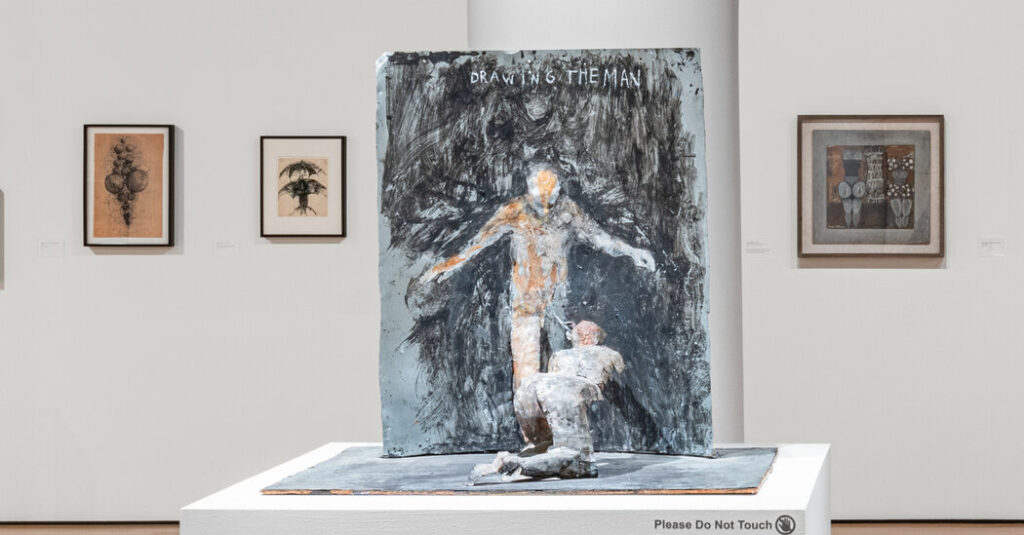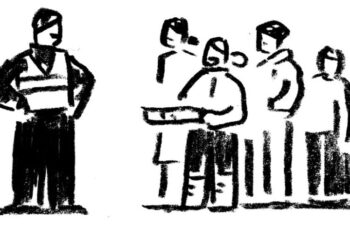June Leaf’s artworks are animated by a force that’s easy to see but difficult to describe. They feel thrillingly dynamic — and not just because some, like her painted fabric scrolls attached to recycled metal cranks, actually do move.
Even her paintings and collages radiate energy, thanks to sketchy, brushy lines and impressionistic imagery. Looking at the 120 pieces in “June Leaf: Shooting From the Heart,” her retrospective on view at Grey Art Museum, in downtown Manhattan, you get the sense of someone who rushed headlong into her work, over and over again.
As she told T magazine in 2022, making art “wears my brain out. I start out with a brain, and then I work, and then I just collapse, as the brain seems to have been lost along the way.” Until the next day, when she repeated the process.
Leaf’s artistic practice began in earnest when she was 18 and continued more or less until her death last year, at 94. She exhibited regularly throughout her life, though mainstream attention was fickle, as it was for many women of her generation. This may have resulted partly from her marriage to the photographer Robert Frank, whose success overshadowed hers; it may also have been because of the somewhat uncategorizable nature of her art.
Leaf’s oeuvre includes oversize soft sculptures, miniature scenes in flattened tin, intimate paintings on paper, the scrolls and much more. Her pieces are united by loose aesthetic principles: Everything is figurative and resolutely handmade, more scrawled and scratchy than polished and perfect.
It’s as if the artworks are sketches — second, fifth or 10th drafts of ideas, manifestations of dreams and thoughts around which she was constantly circling. No wonder she once called herself an “inventor”; there are moments in the current exhibition when she seems to be as much a mad scientist as an artist (for example. two wearable pairs of vision-narrowing glasses). She also referred to herself as a dancer, a choreographer, an archer and an aviator.
Those titles hint at some of her primary concerns: motion, relationships, creativity. (“The secret is not drawing but DANCE,” she wrote atop a 2020 charcoal drawing.) She explored such abstract concepts by placing archetypal figures in suggestive situations, like the two tin people balanced across from each other atop a wavy, floating metal hoop in “The Wheel” (2022). One appears upright and confident, the other perched precariously on its side. There’s no clear story, but the composition is freighted with meaning.
Many of Leaf’s characters are recognizably female. Although she wasn’t explicitly a feminist, her practice often seems driven by a desire to allow women to be protagonists — and messy, capacious ones at that. This began after her stint at the New Bauhaus, a reincarnation of the Weimar-era German art and design school that was founded by László Moholy-Nagy in Chicago in 1937.
Getting to the New Bauhaus had necessitated a struggle with her mother, who wanted the young Leaf to be more conventional. When she arrived, in 1947, her classmates were mostly older men who had enrolled at the school through the G.I. Bill of Rights. Leaf stayed only three months — long enough to have what she called a “total awakening” to contemporary art.
Not long afterward, she began making small, dark drawings and paintings of women as machines with bubbly body parts. By 1956, her mechanistic impulses assumed fuller proportions with the eight-foot-wide painting “Arcade Women,” a brightly colorful, gridded scene. It’s hard to tell if the many seated, faceless, hat-wearing female figures are playing arcade games or somehow fused with the games.
“Arcade Women” is tidy, by Leaf’s standards; it was made when she was back in college (Roosevelt University this time) and teaching art in Chicago. She was also studying art history on her own and hashing out her process and style. That journey took her to Paris on a Fulbright scholarship, then to New York. The culture and life of the city streets inspired her, as they had when she was growing up in Chicago.
In 1968, she had her first solo show in New York, “Street Dreams” at Allan Frumkin Gallery . The carnivalesque exhibition included a cloth-and-wood carousel horse and the showstopping “Woman Theater” (1968), which is on view at Grey. The soft sculpture depicts a big-haired, expressionistically painted woman — naked but for her high heels — whose stomach is a frame that contains a smaller woman inside; she also holds another figure on a rope, like a marionette. It’s unclear whether the miniature characters represent facets of herself or other people, but either way, the large, smiling woman is in charge — a bawdy and benevolent puppet master.
“Street Dreams” received critical acclaim, but two years later, Leaf’s life — and consequently, her art — changed drastically, when she and Frank moved to the tiny town of Mabou in Nova Scotia, at Frank’s behest, and married in 1975. Some of her works on paper from this period are intimate scenes depicted from Leaf’s point of view: We look out on a motel room or studio, with a photograph of Frank or the painted Mabou landscape looming beyond. In the foreground is a rendering of Leaf’s hands — her anchor while she was contending with the uncertainty of her new circumstances.
She found her footing partly through metal, as she began to fashion figures out of tin. These sculptures often contain pairs, like “The Kick” (1976), which features one person booting another, seemingly playfully, although the action occurs on a line that could be a tightrope or the barrel of a gun.
Leaf had a remarkable ability to infuse her characters with energy and expression, despite their general lack of defining features or gender. This, combined with the mystery of their actions, gives them a mythic quality, as if they were enacting age-old scenarios.
One of the strengths of “Shooting From the Heart” is that it’s arranged thematically, which allows the viewer to see the continuities in Leaf’s work, despite her disparate styles and periods. In another smart choice, the curators, Allison Kemmerer, Gordon Wilkins and Sam Adams, make liberal use of Leaf’s own poetic words on the wall labels. “First of all, you don’t invent anything, you just discover the truth,” one text reads. “And the truth is always there.”
The contradiction between that statement and Leaf calling herself an inventor reflects the way that she, to echo the show’s title, shot from the heart. She was not concerned with rigid consistency but instead, like her characters, was messy and capacious and contradictory: Her work was big and loud as well as small and quiet; she loved the city but moved to the country and quit art school even though she was determined to be an artist. She used old, weathered materials, like eggbeaters — she said she had about 2,000 — to envision something new.
One of my favorite pieces in the exhibition is “Woman Drawing the Man” (2014-19), a painted tin sculpture. It features a male figure looking down as he emerges from a wall; a woman kneels before him, holding what looks like a paintbrush up to his crotch. The scene is a clever inversion of the biblical story that says God formed Eve from Adam’s rib: Here, a female artist is a kind of god who’s creating a man with her hands.
The sculpture isn’t triumphant or moralizing, because it’s not a political statement; like so many of Leaf’s works, it’s an allegory. She wasn’t seeking easy lessons or narrative, or even formal innovation, although she achieved it. She created images that felt true — and fortunately for us, they still do.
June Leaf: Shooting From the Heart
Through Dec. 13 at the Grey Art Museum, 18 Cooper Square, Manhattan; 212-998-6780, greyartmuseum.nyu.edu.
The post June Leaf Made Art Like a Mad Scientist, a Dancer, an Aviator and an Archer appeared first on New York Times.




